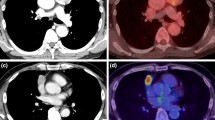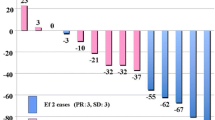Abstract
Purpose
This study was performed to assess the usefulness of 18F-fluorodeoxyglucose (18F-FDG) positron emission tomography (PET) or PET/computed tomography (CT) for distinguishing thymic epithelial tumors according to World Health Organization (WHO) classifications.
Methods
We analyzed a total of 45 patients (range, 29–75 years of age; mean, 55 years) with pathologically confirmed thymic epithelial tumors who underwent pretreatment 18F-FDG PET or PET/CT between November 2003 and October 2009. The size, visual grading of uptake value, peak standardized uptake value (SUVpeak), uptake pattern, and contour of each tumor, and associated findings on PET or PET/CT, were analyzed relative to the three simplified WHO subgroups: less-invasive thymomas (types A and AB), more-invasive thymomas (types B1, B2, and B3) and thymic carcinomas. We statistically assessed the relationship of 18F-FDG PET or PET/CT findings with these simplified subgroups.
Results
Of the 45 patients, ten had less-invasive thymomas, 23 had more-invasive thymomas, and 12 had thymic carcinomas. The SUVpeak of the less- and more-invasive thymomas were significantly lower than those of thymic carcinomas (p < 0.000), but there was no difference in SUVpeak between less- and more-invasive thymomas. The visual grading scale (p < 0.000), uptake pattern (p = 0.001), and contour (p < 0.000) of the tumors differed significantly among the three simplified subgroups.
Conclusion
The image findings of 18F-FDG PET or PET/CT differed significantly by histologic subgroups. Pre-treatment evaluation with 18F-FDG PET or PET/CT might be helpful in differentiating subgroups of thymic epithelial tumors.




Similar content being viewed by others
References
Wright CD (2008) Management of thymomas. Crit Rev Oncol Hematol 65:109–120
Cheng YJ, Kao EL, Chou SH (2005) Videothoracoscopic resection of stage II thymoma: prospective comparison of the results between thoracoscopy and open methods. Chest 128:3010–3012
Jeong YJ, Lee KS, Kim J, Shim YM, Han J, Kwon OJ (2004) Does CT of thymic epithelial tumors enable us to differentiate histologic subtypes and predict prognosis? AJR Am J Roentgenol 183:283–289
Sung YM, Lee KS, Kim BT, Choi JY, Shim YM, Yi CA (2006) 18F-FDG PET/CT of thymic epithelial tumors: usefulness for distinguishing and staging tumor subgroups. J Nucl Med 47:1628–1634
Shibata H, Nomori H, Uno K, Sakaguchi K, Nakashima R, Iyama K et al (2009) 18F-fluorodeoxyglucose and 11C-acetate positron emission tomography are useful modalities for diagnosing the histologic type of thymoma. Cancer 115:2531–2538
Wahl RL, Jacene H, Kasamon Y, Lodge MA (2009) From RECIST to PERCIST: evolving considerations for PET response criteria in solid tumors. J Nucl Med 50:122S–150S
Kim DJ, Yang WI, Choi SS, Kim KD, Chung KY (2005) Prognostic and clinical relevance of the World Health Organization schema for the classification of thymic epithelial tumors: a clinicopathologic study of 108 patients and literature review. Chest 127:755–761
Okumura M, Shiono H, Minami M, Inoue M, Utsumi T, Kadota Y et al (2008) Clinical and pathological aspects of thymic epithelial tumors. Gen Thorac Cardiovasc Surg 56:10–16
Augustin F, Schmid T, Sieb M, Lucciarini P, Bodner J (2008) Video-assisted thoracoscopic surgery versus robotic-assisted thoracoscopic surgery thymectomy. Ann Thorac Surg 85:S768–S771
Tomaszek S, Wigle DA, Keshavjee S, Fischer S (2009) Thymomas: review of current clinical practice. Ann Thorac Surg 87:1973–1980
Casey EM, Kiel PJ, Loehrer PJ Sr (2008) Clinical management of thymoma patients. Hematol Oncol Clin N Am 22:457–473
Ali SZ, Erozan YS (1998) Thymoma. Cytopathologic features and differential diagnosis on fine needle aspiration. Acta Cytol 42:845–854
Chhieng DC, Rose D, Ludwig ME, Zakowski MF (2000) Cytology of thymomas: emphasis on morphology and correlation with histologic subtypes. Cancer 90:24–32
Shin HJ, Katz RL (1998) Thymic neoplasia as represented by fine needle aspiration biopsy of anterior mediastinal masses. A practical approach to the differential diagnosis. Acta Cytol 42:855–864
Liu RS, Yeh SH, Huang MH, Wang LS, Chu LS, Chang CP et al (1995) Use of fluorine-18 fluorodeoxyglucose positron emission tomography in the detection of thymoma: a preliminary report. Eur J Nucl Med 22:1402–1407
Sasaki M, Kuwabara Y, Ichiya Y, Akashi Y, Yoshida T, Nakagawa M et al (1999) Differential diagnosis of thymic tumors using a combination of 11C-methionine PET and FDG PET. J Nucl Med 40:1595–1601
Kumar A, Regmi SK, Dutta R, Kumar R, Gupta SD, Das P et al (2009) Characterization of thymic masses using 18F-FDG PET-CT. Ann Nucl Med 23:569–577
Tomiyama N, Johkoh T, Mihara N, Honda O, Kozuka T, Koyama M et al (2002) Using the World Health Organization Classification of thymic epithelial neoplasms to describe CT findings. AJR Am J Roentgenol 179:881–886
Okumura M, Miyoshi S, Fujii Y, Takeuchi Y, Shiono H, Inoue M et al (2001) Clinical and functional significance of WHO classification on human thymic epithelial neoplasms: a study of 146 consecutive tumors. Am J Surg Pathol 25:103–110
Okumura M, Ohta M, Tateyama H, Nakagawa K, Matsumura A, Maeda H et al (2002) The World Health Organization histologic classification system reflects the oncologic behavior of thymoma: a clinical study of 273 patients. Cancer 94:624–632
Acknowledgements
This study was supported by a grant from the Korea Healthcare Technology R&D Project, Ministry for Health, Welfare and Family Affairs, Republic of Korea (A084136).
Author information
Authors and Affiliations
Corresponding author
Rights and permissions
About this article
Cite this article
Kim, J.Y., Kim, H.O., Kim, J.S. et al. 18F-FDG PET/CT is Useful for Pretreatment Assessment of the Histopathologic Type of Thymic Epithelial Tumors. Nucl Med Mol Imaging 44, 177–184 (2010). https://doi.org/10.1007/s13139-010-0036-x
Received:
Revised:
Accepted:
Published:
Issue Date:
DOI: https://doi.org/10.1007/s13139-010-0036-x




